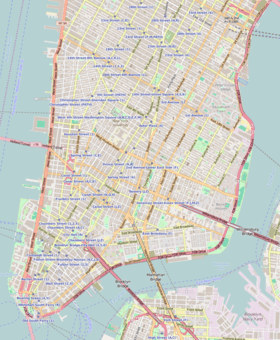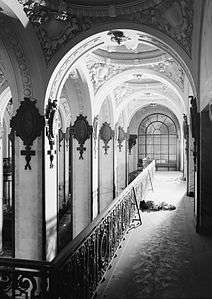Singer Building
| Singer Building | |
|---|---|
 | |
 Singer Building Location within Lower Manhattan  Singer Building Singer Building (New York)  Singer Building Singer Building (the US) | |
| Record height | |
| Tallest in the world from 1908 to 1909[I] | |
| Preceded by | Philadelphia City Hall |
| Surpassed by | Metropolitan Life Insurance Company Tower |
| General information | |
| Status | Demolished |
| Type | Commercial offices |
| Location |
149 Broadway New York City, New York |
| Coordinates | 40°42′35″N 74°00′36″W / 40.70982°N 74.01001°WCoordinates: 40°42′35″N 74°00′36″W / 40.70982°N 74.01001°W |
| Completed | 1908 |
| Demolished | 1968 |
| Height | |
| Roof | 186.6 m (612 ft) |
| Technical details | |
| Floor count | 47 |
| Design and construction | |
| Architect | Ernest Flagg |
| Structural engineer | Boller & Hodge |
| Main contractor | General Supply & Construction Company |
| References | |
| [1][2][3] | |
The Singer Building or Singer Tower, at Liberty Street and Broadway in Lower Manhattan's Financial District, in the U.S. state of New York, was a 47-story office building completed in 1908 as the headquarters of the Singer Manufacturing Company.[4] It was the tallest building in the world from 1908 to 1909. It was torn down in 1968, together with the adjacent City Investing Building, and is now the site of One Liberty Plaza. When it was razed, it became the tallest building ever to be demolished,[5] and is currently the third-tallest building ever to be destroyed (after the World Trade Center towers) and the tallest to be purposely demolished by its owner.
History
Construction and design
The building was commissioned by Frederick Bourne, the head of the Singer Sewing Machine Company. He hired architect Ernest Flagg, who was an early exponent of the Beaux-Arts architectural style.[6] Flagg had also designed the company's previous headquarters at 561 Broadway between Prince and Spring Streets—in what is now the SoHo neighborhood—which was referred to as the "Little Singer Building" after the new building was erected.[7][8] Plans and working drawings were prepared by George W. Conable.[9]
Flagg believed that buildings more than 10 or 15 stories high should be set back from the street, with the tower occupying only a quarter of the lot.[6] The 12-story base of the building filled an entire blockfront, while the tower above was relatively narrow. The tower floors were squares 65 feet (20 m) on a side.
New York Times architectural critic Christopher Gray wrote in 2005:
The lobby had the quality of "celestial radiance" seen in world's-fair and exposition architecture of the period, as the author Mardges Bacon described it in her 1986 monograph "Ernest Flagg" (Architectural History Foundation, MIT Press). A forest of marble columns rose high to a series of multiple small domes of delicate plasterwork, and Flagg trimmed the columns with bronze beading. A series of large bronze medallions placed at the top of the columns were alternately rendered in the monogram of the Singer company and, quite inventively, as a huge needle, thread and bobbin.[6]
At 612 feet (187 m) tall, the Singer Building was the tallest office building in the world from its completion in 1908 until the completion in 1909 of the 700-foot (210 m) Metropolitan Life Insurance Company Tower at 23rd Street and Madison Avenue in Manhattan.[6]
Early history and tenants
As of November 1921, Catham and Phenix National Bank had its main office in the Singer Building.[10]
Later history and demolition
In 1961, Singer sold the building and subsequently moved to Rockefeller Center.[6][11] The building was then acquired by real estate developer William Zeckendorf, who sought unsuccessfully for the New York Stock Exchange to move there. In 1964, United States Steel acquired the building, along with the neighboring City Investing Building, for demolition. By the 1960s, the building was uneconomical because of its small interior dimensions. The tower portion of the building contained only 4,200 square feet (390 m2) per floor, compared with 37,000 square feet (3,400 m2) per floor of the building that replaced it, the U.S. Steel Building (currently known as One Liberty Plaza).[6]
Although New York had a newly created Landmarks Preservation Commission by the time demolition commenced in 1967, and the Singer Building was considered to be one of the most iconic buildings in the city, it did not receive landmark designation, which would have prevented it from being torn down. Alan Burnham, executive director of the commission, said in August 1967 that if the building were to have been made a landmark, the city would have to either find a buyer for it or acquire it. Demolition commenced in August 1967 and was completed the following year. At the time, it was the tallest building ever to be destroyed until the September 11, 2001 attacks, when the World Trade Center one block over collapsed. The Singer Building is currently the third-tallest building to be destroyed but is still the tallest building whose razing was anticipated.[12]
Gallery
 Singer Building with the Hudson Terminal
Singer Building with the Hudson Terminal The building seen from Broadway
The building seen from Broadway The interior view of the lobby mezzanine
The interior view of the lobby mezzanine
See also
References
- ↑ Singer Building at Emporis
- ↑ "Singer Building". SkyscraperPage.
- ↑ Singer Building at Structurae
- ↑ Ripley, Charles M. (October 1907). "A Building Forty-Seven Stories High". The World's Work: A History of Our Time. XIV: 9459–9461. Retrieved 2009-07-10.
- ↑ Jon Kelly (6 December 2012). "How do you demolish a skyscraper?". BBC News Magazine. BBC. Retrieved 12 December 2012.
- 1 2 3 4 5 6 Gray, Christopher (2 January 2005). "Streetscapes: Once the Tallest Building, but Since 1967 a Ghost". The New York Times. Retrieved 1 August 2010.
- ↑ White, Norval & Willensky, Elliot (2000), AIA Guide to New York City (4th ed.), New York: Three Rivers Press, ISBN 978-0-8129-3107-5 , p.100
- ↑ Gray, Christopher (29 June 1997). "Style Standard for Early Steel-Framed Skyscraper". The New York Times. p. 7. Retrieved 1 August 2010.
- ↑ Larry E. Gobrecht (April 1983). "National Register of Historic Places Registration: Jamaica Chamber of Commerce Building". New York State Office of Parks, Recreation and Historic Preservation. Archived from the original on 2013-05-23. Retrieved 2011-01-16.
- ↑ Catham & Phenix Completes Merger; Buys Control in New York County National, to Be Made a Twelfth Branch. Expansion Policy is Old - Larger Institution Has Increased Its Trade Centres Ever Since Middle of Last Century., New York City: The New York Times, November 8, 1921, p. 37, retrieved February 16, 2017
- ↑ Fried, Joseph P. (Aug 22, 1967). "Landmark on Lower Broadway to Go". The New York Times. Retrieved 2 August 2010.
- ↑ White, Norval & Willensky, Elliot (2000), AIA Guide to New York City (4th ed.), New York: Three Rivers Press, ISBN 978-0-8129-3107-5 , p.42
External links
| Wikimedia Commons has media related to 149 Broadway Singer Building. |
- Old postcard view of the Singer Building on bc.edu
- The Little Singer Building (561 Broadway)
- The Lost Skyscrapers of Bygone New York
| Records | ||
|---|---|---|
| Preceded by Philadelphia City Hall |
Tallest building in the world 1908–1909 187 m |
Succeeded by Metropolitan Life Insurance Company Tower |
| Tallest building in the United States 1908–1909 187 m | ||
| Preceded by Park Row Building |
Tallest building in New York 1906–1909 187 m |
Succeeded by Metropolitan Life Insurance Company Tower |
.png)